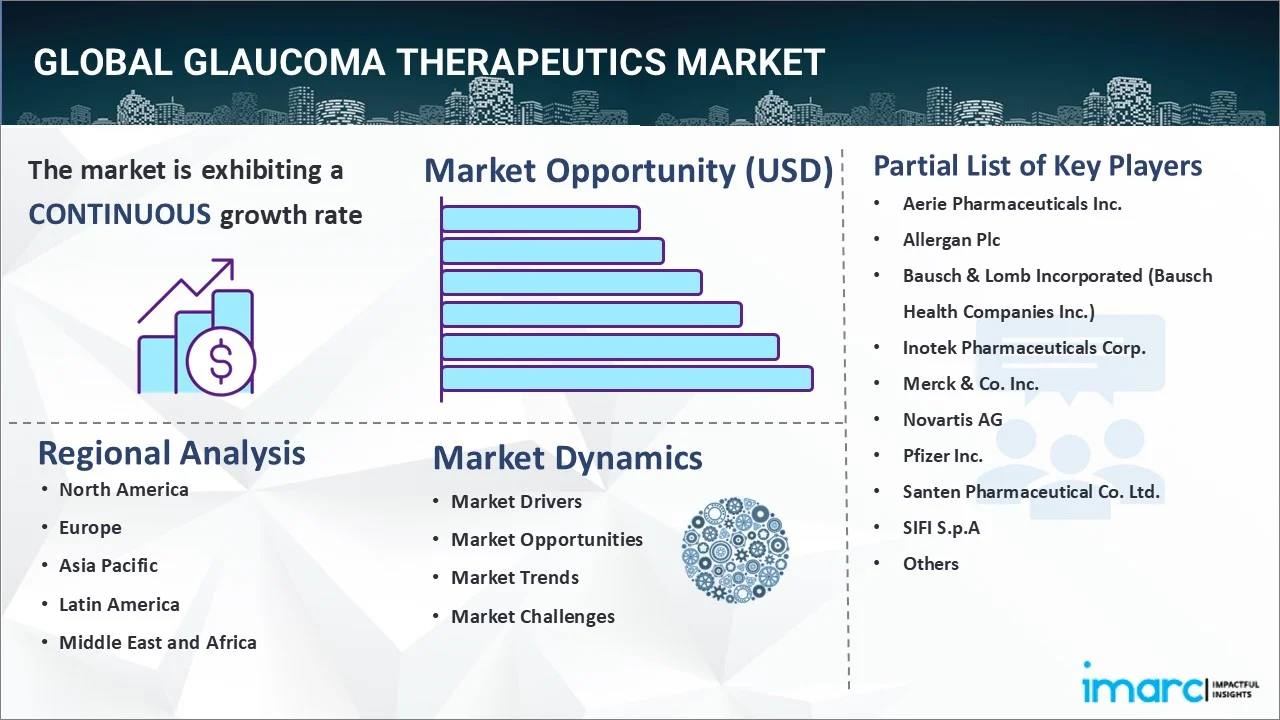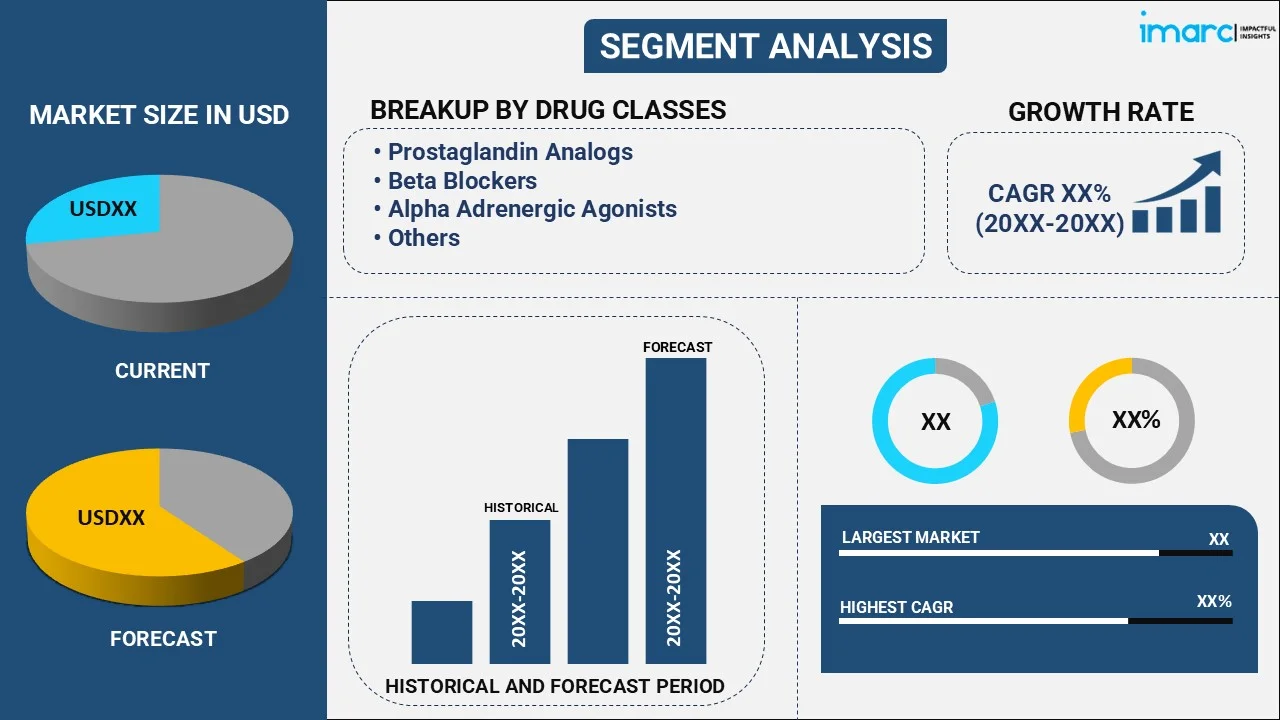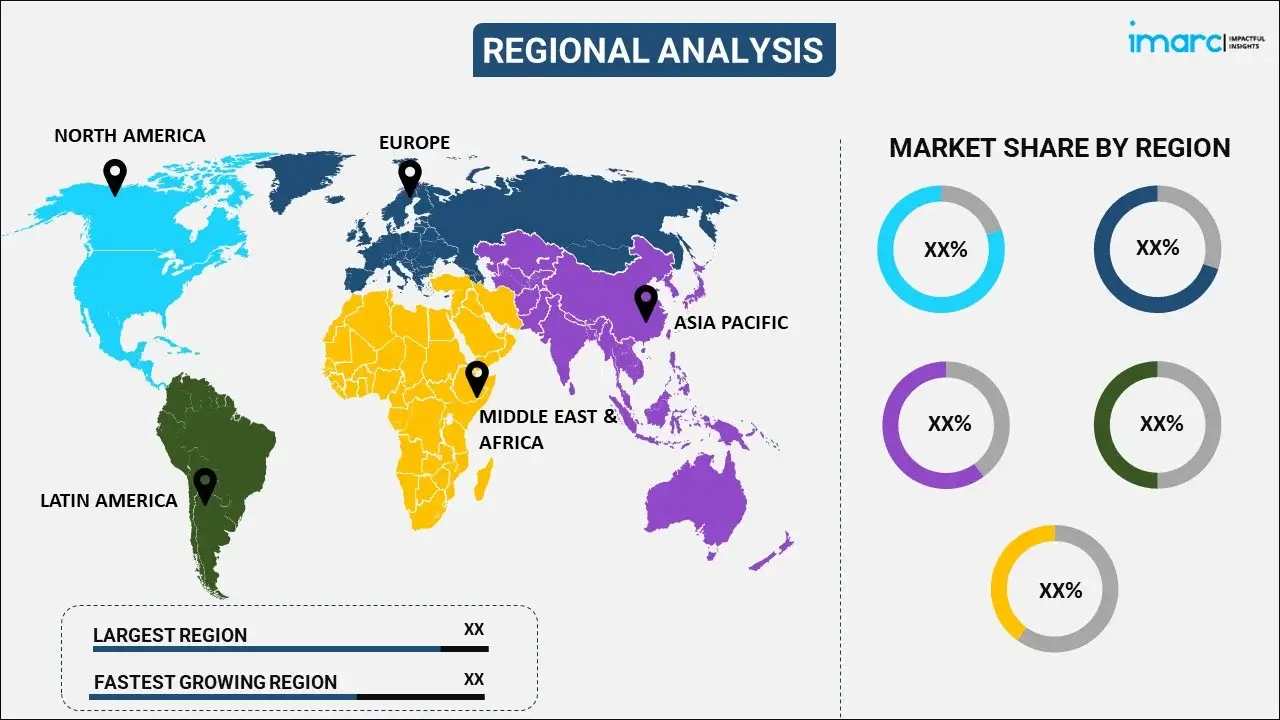
Glaucoma Therapeutics Market Report by Drug Class (Prostaglandin Analogs, Beta Blockers, Alpha Adrenergic Agonists, Carbonic Anhydrase Inhibitors, Combination Drugs, and Others), Indication (Open Angle Glaucoma, Angle Closure Glaucoma, and Others), End User (Hospitals, Ophthalmic Clinics, Ambulatory Surgery Centers, and Others), and Region 2025-2033
Market Overview:
The global glaucoma therapeutics market size reached USD 8.4 Billion in 2024. Looking forward, IMARC Group expects the market to reach USD 14.1 Billion by 2033, exhibiting a growth rate (CAGR) of 5.35% during 2025-2033. The growing prevalence of glaucoma across the globe, continual advancements in diagnostic technologies for early detection, the rising adoption of telemedicine in ophthalmology, and numerous technological innovations in surgical procedures represent some of the factors that are propelling the market.
|
Report Attribute
|
Key Statistics
|
|---|---|
|
Base Year
|
2024 |
|
Forecast Years
|
2025-2033
|
|
Historical Years
|
2019-2024
|
| Market Size in 2024 | USD 8.4 Billion |
| Market Forecast in 2033 | USD 14.1 Billion |
| Market Growth Rate (2025-2033) |
5.35%
|
Glaucoma Therapeutics Market Analysis:
- Market Growth and Size: The global glaucoma therapeutics market is experiencing moderate growth, driven by factors like the increasing prevalence of glaucoma globally and a rising aging population susceptible to this eye condition.
- Major Market Drivers: Key drivers include the growing awareness among individuals about the importance of early diagnosis and treatment.
- Key Market Trends: There is a notable shift towards the adoption of combination therapies and the development of novel drug delivery systems, which are poised to revolutionize glaucoma management. These trends are driven by the need for more effective treatment regimens and improved patient compliance.
- Geographical Trends: North America dominates the market, driven by high healthcare expenditure, a well-established healthcare infrastructure, and heightened awareness about glaucoma. However, Asia Pacific is emerging as a fast-growing market on account of the increasing healthcare investments and improving healthcare facilities.
- Competitive Landscape: The market is moderately competitive, with several global players dominating the scene. These companies are engaged in research and development (R&D) activities, strategic alliances, and mergers and acquisitions (M&As) to consolidate their market positions and expand their product portfolios.
- Challenges and Opportunities: Challenges include stringent regulatory frameworks, high treatment costs, and a lack of awareness in underdeveloped regions. Nonetheless, opportunities for market players to innovate and differentiate their offerings are projected to overcome these challenges.

Glaucoma Therapeutics Market Trends/Drivers:
Numerous technological innovation in surgical procedures
The advent of technological innovation in surgical procedures has significantly influenced the global market. One of the most groundbreaking developments is Minimally Invasive Glaucoma Surgeries (MIGS). These surgical interventions have proved to be transformative by causing fewer complications, necessitating shorter recovery periods, and being easier to perform than traditional surgical methods like trabeculectomy. The ease of MIGS has empowered surgeons with more options to manage the disease effectively while minimizing the potential risks and discomfort to the patient. In addition, advancements in surgical medical devices such as micro-stents and new drainage systems have further improved the effectiveness of glaucoma surgeries. These advancements have, in turn, increased the trust among healthcare practitioners and patients across the globe in surgical solutions as viable treatment options for glaucoma.
Rising adoption of telemedicine in ophthalmology
Telemedicine has increasingly become an integral part of healthcare, and its applications in ophthalmology are particularly noteworthy when it comes to the glaucoma therapeutics market. The digitalization of healthcare, coupled with technological advancements in software and hardware, has made remote consultations both practical and effective. Patients can now have their conditions monitored without the need for frequent hospital visits, which is especially beneficial for those residing in rural or remote locations. This wider reach of healthcare services enhances patient engagement, thereby contributing to better outcomes. Remote consultations enable continuous monitoring, and real-time data can alert healthcare providers to changes in a patient's condition that may require immediate intervention. The enhanced data collection capabilities also offer unprecedented opportunities for research, thereby potentially accelerating the development of new treatment modalities.
An enhanced focus on holistic approaches to patient care
An integrated, holistic treatment plan often involves a multi-disciplinary team of healthcare providers, including nutritionists, physiotherapists, and psychological counselors, among others. This not only gives patients a more comprehensive treatment plan but also opens up cross-selling and up-selling opportunities within the healthcare ecosystem. The focus has moved beyond treating the symptoms to a more integrated approach, taking into account patient education, lifestyle changes, and preventive measures alongside medical interventions. A holistic approach also recognizes the role of lifestyle factors such as diet, exercise, and stress management in managing glaucoma. Patients are educated about the types of foods and activities that can help in reducing intraocular pressure, which is a critical factor in glaucoma. This multi-pronged approach not only enhances the effectiveness of medical treatments but also improves the overall quality of life for the patients.
Glaucoma Therapeutics Industry Segmentation:
IMARC Group provides an analysis of the key trends in each segment of the global glaucoma therapeutics market report, along with forecasts at the global, regional, and country levels for 2025-2033. Our report has categorized the market based on drug class, indication and end user.
Breakup by Drug Class:

- Prostaglandin Analogs
- Beta Blockers
- Alpha Adrenergic Agonists
- Carbonic Anhydrase Inhibitors
- Combination Drugs
- Others
Prostaglandin analogs represents the largest market segment
The report has provided a detailed breakup and analysis of the market based on the drug class. This includes prostaglandin analogs, beta blockers, alpha adrenergic agonists, carbonic anhydrase inhibitors, combination drugs and others. According to the report, prostaglandin analogs represented the largest segment.
The prostaglandin analogs segment in the market is predominantly driven by their efficacy in reducing intraocular pressure with fewer systemic side effects compared to other classes of glaucoma medications. The once-daily dosing convenience of these drugs also contributes to patient compliance, thereby increasing its market demand. Innovation in formulations and delivery mechanisms is another major factor contributing to its market share. Intellectual property expiry and subsequent entry of generics, however, pose a challenge to market growth. Lastly, their versatile compatibility with other classes of glaucoma medications makes them a preferred choice in combination therapies, bolstering the segment's prominence.
On the other hand, the beta blockers, alpha adrenergic agonists, carbonic anhydrase inhibitors, combination drugs and other segments are influenced by a diverse range of factors such as affordability, varied mechanisms of action, and well-established safety profiles. These drugs are often prescribed in cases where Prostaglandin Analogs are contraindicated or not effective. Despite their efficacy, the need for multiple daily dosing can impact patient compliance. Availability of generics in this category also makes it a cost-effective option for treatment.
Breakup by Indication:
- Open Angle Glaucoma
- Angle Closure Glaucoma
- Others
Open angle glaucoma represents the largest market segment
The report has provided a detailed breakup and analysis of the market based on the indication. This includes open angle glaucoma, angle closure glaucoma and others. According to the report, open angle glaucoma represented the largest segment.
The open-angle glaucoma segment is primarily fueled by its prevalence, constituting the majority of glaucoma cases globally. Increased awareness and advancements in diagnostic techniques have led to earlier and more frequent detection of this condition. The availability of multiple treatment options, ranging from medications to surgeries, offers a comprehensive approach to managing open-angle glaucoma. Aging demographics further amplify the incidence rates, thereby driving glaucoma therapeutics market demand. Government initiatives aimed at eye health contribute to the overall market growth for this segment.
On the other hand, the growth in angle closure glaucoma and other segments is primarily driven by an aging population, as the condition is more prevalent among older adults. Advances in diagnostic technologies have also contributed to the segment's expansion by enabling earlier and more accurate detection of the condition. In addition, the increased awareness about the severity of untreated angle-closure glaucoma, which can lead to blindness, has led to higher demand for effective treatments.
Breakup by End User:
- Hospitals
- Ophthalmic Clinics
- Ambulatory Surgery Centers
- Others
Hospitals accounts for the majority of the market share
The report has provided a detailed breakup and analysis of the market based on the end user. This includes hospitals, ophthalmic clinics, ambulatory surgery centers and others. According to the report, hospitals represented the largest segment.
Hospitals are major consumers in the glaucoma therapeutics market, given their capability to offer advanced diagnostic and surgical interventions. The consolidation of healthcare facilities and investment in state-of-the-art ophthalmic departments contribute to the segment's growth. Additionally, hospitals are often the first point of contact for emergency eye conditions, thereby positioning them as crucial stakeholders. Public and private insurance coverages also incentivize treatment in hospital settings, increasing patient throughput and consumption of glaucoma medications.
On the other hand, the growth in ophthalmic clinics, ambulatory surgery centers, and other segments can be attributed to the specialized focus on eye care, the availability of advanced diagnostic equipment, and faster patient turnover. Increasing consumer preference for specialized care is also a contributing factor. Decentralization of healthcare services and the expansion of ambulatory surgery centers make these settings accessible for minor procedures and regular check-ups. The growth is further supported by flexible payment options and shorter waiting times.
Breakup by Region:

- North America
- United States
- Canada
- Asia Pacific
- China
- Japan
- India
- South Korea
- Australia
- Indonesia
- Others
- Europe
- Germany
- France
- United Kingdom
- Italy
- Spain
- Russia
- Others
- Latin America
- Brazil
- Mexico
- Others
- Middle East and Africa
North America exhibits a clear dominance, accounting for the largest glaucoma therapeutics market share
The glaucoma therapeutics market research report has also provided a comprehensive analysis of all the major regional markets, which include North America (the United States and Canada); Asia Pacific (China, Japan, India, South Korea, Australia, Indonesia, and others); Europe (Germany, France, the United Kingdom, Italy, Spain, Russia, and others); Latin America (Brazil, Mexico, and others); and the Middle East and Africa. According to the report, North America accounted for the largest market share.
The market in the North America region is significantly impelled by high healthcare expenditure, robust insurance frameworks, and the presence of leading pharmaceutical companies are primary drivers. Furthermore, the region is home to a diverse and aging population, thereby creating a natural demand for glaucoma treatments. Technological advancements in drug formulation and delivery, backed by substantial investments in research and development, also fuel glaucoma therapeutics market growth.
Regulatory support in terms of expedited approvals and grants fosters innovation, providing a favorable environment for market expansion. Government initiatives in healthcare education and eye screenings contribute to early diagnosis and, in turn, drive demand for therapeutics. Accessibility to specialty ophthalmic clinics and ambulatory surgery centers adds another layer of convenience, encouraging timely intervention.
The availability of both branded and generic drugs offers options across various price points, catering to a wide consumer base. Furthermore, collaborations between public and private sectors in healthcare initiatives serve to increase awareness as well as facilitate entry and acceptance of novel therapeutic solutions in the market.
Competitive Landscape:
The major players in the market are persistently working to develop more effective and less invasive treatment options. They are investing heavily in clinical trials to produce medicines and devices that provide longer-lasting relief with fewer side effects. Collaborations with research institutions and healthcare organizations are common strategies these key players are adopting. Market leaders are also expanding their portfolios by launching innovative products specifically designed to manage different types of glaucoma. Furthermore, these companies are working diligently to meet stringent regulatory requirements, ensuring that their products are both safe and effective. Furthermore, they are also focusing on patient education and awareness programs as a part of their market expansion strategies, thereby offering a favorable glaucoma therapeutics market outlook.
The report has provided a comprehensive analysis of the competitive landscape in the market. Detailed profiles of all major companies have also been provided. Some of the key players in the market include:
- Aerie Pharmaceuticals Inc.
- Allergan Plc
- Bausch & Lomb Incorporated (Bausch Health Companies Inc.)
- Inotek Pharmaceuticals Corp.
- Merck & Co. Inc.
- Novartis AG
- Pfizer Inc.
- Santen Pharmaceutical Co. Ltd.
- SIFI S.p.A
- Teva Pharmaceutical Industries Ltd
Recent Developments:
- In November 2022, Aerie Pharmaceuticals, Inc. was acquired by Alcon, the global leader in eye care. Through the transaction, Alcon has added the commercial products Rocklatan(netarsudil and latanoprost ophthalmic solution) 0.02%/0.005% and Rhopressa(netarsudil ophthalmic solution) 0.02%, AR-15512, a Phase 3 product candidate for dry eye disease and also a pipeline of ophthalmic pharmaceutical product candidates.
- In July 2023, Bausch Health Companies Inc. announced that Bausch Receivables Funding LP, an Ontario limited partnership and wholly-owned subsidiary of Bausch Health, has entered into a $600 million non-recourse financing facility with KKR and its credit funds and accounts. The facility will be collateralized by certain accounts receivables originated by a wholly-owned subsidiary of Bausch Health.
- Merck & Co. announced that the European Commission (EC) has approved KEYTRUDA, Merck’s anti-PD-1 therapy, in combination with trastuzumab, fluoropyrimidine- and platinum-containing chemotherapy, for the first-line treatment of locally advanced unresectable or metastatic human epidermal growth factor receptor 2 (HER2)-positive gastric or gastroesophageal junction (GEJ) adenocarcinoma in adults whose tumors express PD-L1 (Combined Positive Score [CPS] ≥1).
Glaucoma Therapeutics Market Report Scope:
| Report Features | Details |
|---|---|
| Base Year of the Analysis | 2024 |
| Historical Period | 2019-2024 |
| Forecast Period | 2025-2033 |
| Units | Billion USD |
| Scope of the Report | Exploration of Historical Trends and Market Outlook, Industry Catalysts and Challenges, Segment-Wise Historical and Predictive Market Assessment:
|
| Drug Classes Covered | Prostaglandin Analogs, Beta Blockers, Alpha Adrenergic Agonists, Carbonic Anhydrase Inhibitors, Combination Drugs, Others |
| Indications Covered | Open Angle Glaucoma, Angle Closure Glaucoma, Others |
| End Users Covered | Hospitals, Ophthalmic Clinics, Ambulatory Surgery Centers, Others |
| Regions Covered | Asia Pacific, Europe, North America, Latin America, Middle East and Africa |
| Countries Covered | United States, Canada, Germany, France, United Kingdom, Italy, Spain, Russia, China, Japan, India, South Korea, Australia, Indonesia, Brazil, Mexico |
| Companies Covered | Aerie Pharmaceuticals Inc., Allergan Plc, Bausch & Lomb Incorporated (Bausch Health Companies Inc.), Inotek Pharmaceuticals Corp., Merck & Co. Inc., Novartis AG, Pfizer Inc., Santen Pharmaceutical Co. Ltd., SIFI S.p.A, Teva Pharmaceutical Industries Ltd, etc. |
| Customization Scope | 10% Free Customization |
| Post-Sale Analyst Support | 10-12 Weeks |
| Delivery Format | PDF and Excel through Email (We can also provide the editable version of the report in PPT/Word format on special request) |
Key Benefits for Stakeholders:
- IMARC’s industry report offers a comprehensive quantitative analysis of various market segments, historical and current market trends, market forecasts, and dynamics of the glaucoma therapeutics market from 2019-2033.
- The research report provides the latest information on the market drivers, challenges, and opportunities in the global glaucoma therapeutics market.
- The study maps the leading, as well as the fastest-growing, regional markets. It further enables stakeholders to identify the key country-level markets within each region.
- Porter's five forces analysis assist stakeholders in assessing the impact of new entrants, competitive rivalry, supplier power, buyer power, and the threat of substitution. It helps stakeholders to analyze the level of competition within the glaucoma therapeutics industry and its attractiveness.
- Competitive landscape allows stakeholders to understand their competitive environment and provides an insight into the current positions of key players in the market.
Key Questions Answered in This Report
The global glaucoma therapeutics market was valued at USD 8.4 Billion in 2024.
We expect the global glaucoma therapeutics market to exhibit a CAGR of 5.35% during 2025-2033.
The rising prevalence of glaucoma, along with the growing number of consumer awareness regarding the availability of effective glaucoma therapeutics, is primarily driving the global glaucoma therapeutics market.
The sudden outbreak of the COVID-19 pandemic had led to the postponement of elective glaucoma treatment procedures to reduce the risk of the coronavirus infection upon hospital visits and interaction with healthcare professionals, thereby negatively impacting the global market for glaucoma therapeutics.
Based on the drug class, the global glaucoma therapeutics market can be segmented into prostaglandin analogs, beta blockers, alpha adrenergic agonists, carbonic anhydrase inhibitors, combination drugs, and others. Currently, prostaglandin analogs account for the majority of the total market share.
Based on the indication, the global glaucoma therapeutics market has been divided into open angle glaucoma, angle closure glaucoma, and others. Among these, open angle glaucoma currently holds the largest market share.
Based on the end user, the global glaucoma therapeutics market can be bifurcated into hospitals, ophthalmic clinics, ambulatory surgery centers, and others. Currently, hospitals exhibit a clear dominance in the market.
On a regional level, the market has been classified into North America, Asia Pacific, Europe, Latin America, and Middle East and Africa, where North America currently dominates the global market.
Some of the major players in the global glaucoma therapeutics market include Aerie Pharmaceuticals Inc., Allergan Plc, Bausch & Lomb Incorporated (Bausch Health Companies Inc.), Inotek Pharmaceuticals Corp., Merck & Co. Inc., Novartis AG, Pfizer Inc., Santen Pharmaceutical Co. Ltd., SIFI S.p.A, and Teva Pharmaceutical Industries Ltd.
Need more help?
- Speak to our experienced analysts for insights on the current market scenarios.
- Include additional segments and countries to customize the report as per your requirement.
- Gain an unparalleled competitive advantage in your domain by understanding how to utilize the report and positively impacting your operations and revenue.
- For further assistance, please connect with our analysts.
 Inquire Before Buying
Inquire Before Buying
 Speak to an Analyst
Speak to an Analyst
 Request Brochure
Request Brochure
 Request Customization
Request Customization




.webp)




.webp)












